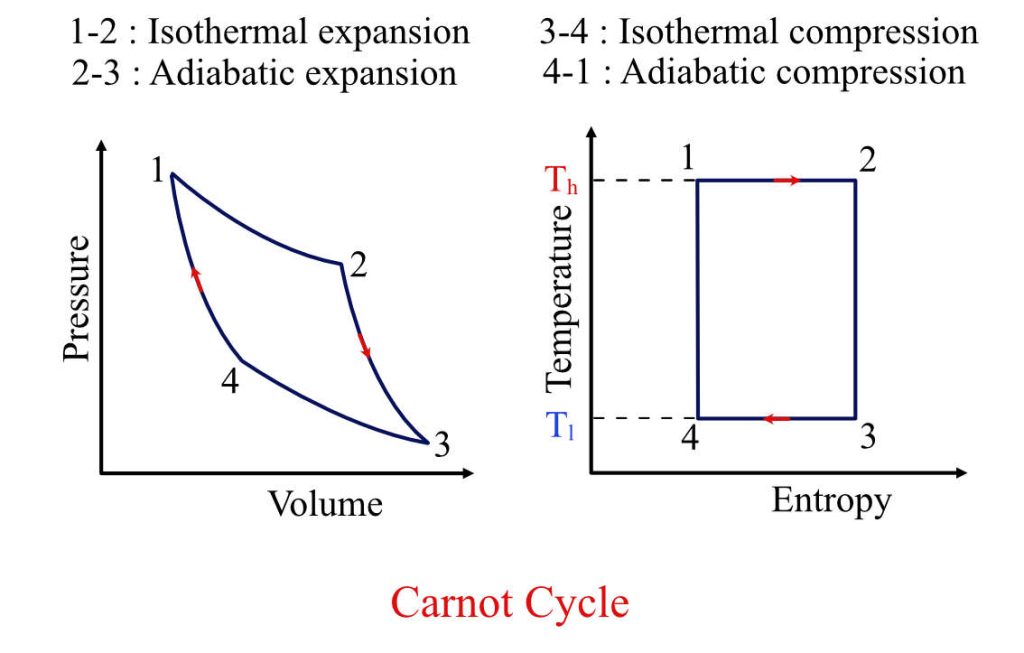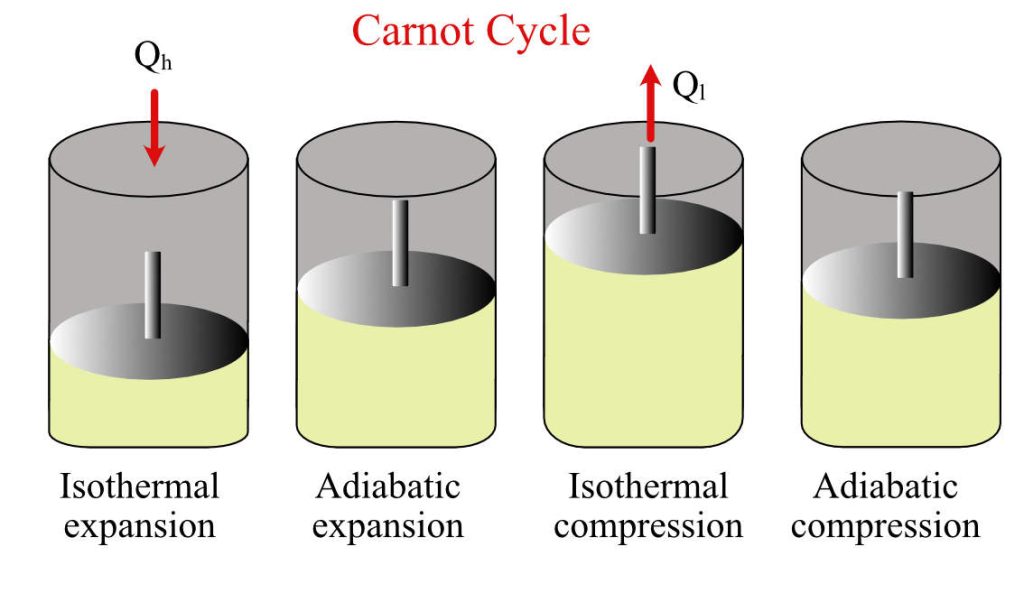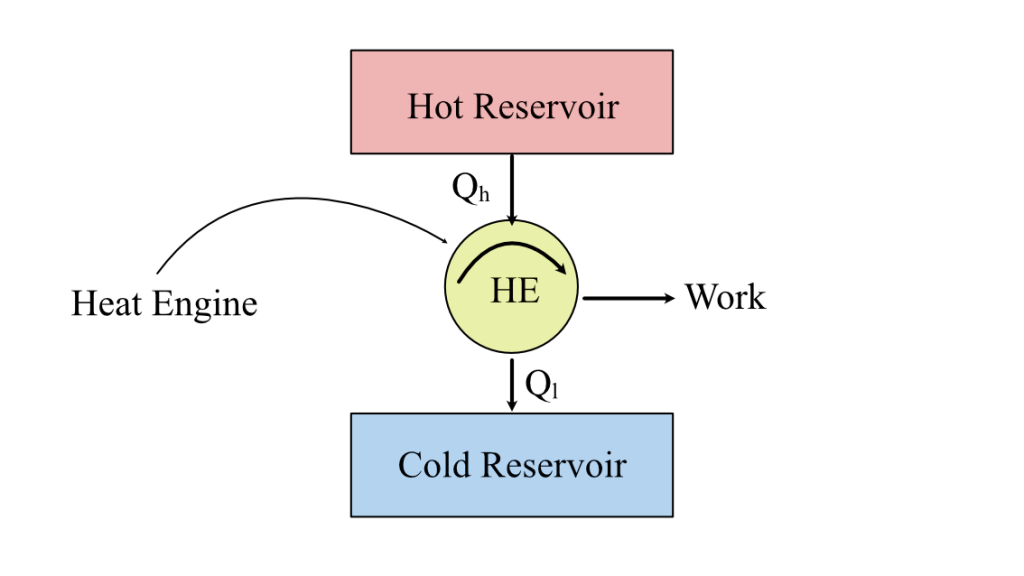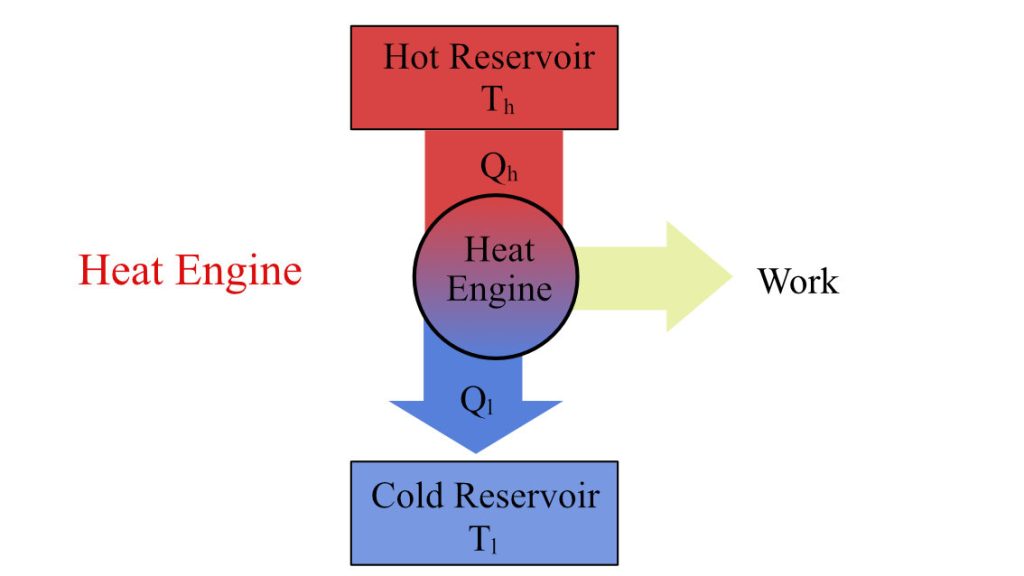An attempt to make an engine extremely efficient led to the formulation of the Carnot engine, which works on a Carnot Cycle. The biggest challenge for scientists and engineers has been achieving the highest engine efficiency. But, have they achieved that highest efficiency, and is that 100%? All these questions are answered in this post through the basic definition and detailed explanations.
Interestingly, this engine also relates to a very controversial topic in the scientific community, the concept of Perpetual Motion Machines. Let us find out how.
Carnot Cycle
Every technological advancement or scientific breakthrough happens when someone tries to push the boundaries. This same thing led to the existence of the Carnot cycle. In the 1820s, the French engineer Nicolas Leonard Sardi Carnot took an interest in improving the efficiency of practical heat engines. The study led him to propose a thermodynamic cycle that can achieve the highest possible efficiency between two temperatures.
Although the hypothetical cycle laid the foundation of efficient reversible cycles for steam power plants, refrigerators, and the heat pump. And eventually led to the development of one of the most important statements of thermodynamics.
Carnot cycle, the thermodynamic cycle as proposed by him, consist of four stages involving reversible thermodynamic process.

The four processes of the Carnot cycle, as shown in the figure, are:
- Isothermal expansion: The system is in contact with a heat reservoir at the temperature (Th), allowing it to absorb heat isothermally and generate work by expansion. Since the process happens isothermally, it doesn’t change the system’s internal energy.
- Adiabatic expansion: The system is thermally insulated from the surroundings and allowed to expand further, doing work. The expansion leads to a drop in temperature from Th to Tl.
- Isothermal compression: The system is placed in thermal contact with the heat sink at temperature Tl, allowing it to reject heat isothermally when it is compressed.
- Adiabatic compression: The system is thermally insulated from the surroundings and is subjected to compression that raises its temperature back to Th.

Carnot Engine
The Carnot engine is a theoretical engine that works on the Carnot cycle operating between two temperatures, T1 (source) and T2 (sink). These temperatures limit the working temperature between which these engines operate. The Carnot cycle, the thermodynamic cycle defined for this engine, estimates the maximum possible efficiency a heat engine can achieve working between those temperatures.
Even though any engine can have irreversibilities in the form of friction and non-quasi-static behavior. The French engineer Nicolas Leonard Sardi Carnot proposed a cycle that can eliminate these irreversibilities and set a benchmark for the heat engine.

One interesting aspect of these engines is that the work output of these engines is independent of the system’s material.
💡 Carnot Principle: No engine working between two reservoirs at constant temperatures can have an efficiency greater than a reversible engine.
Carnot Theorem & Efficiency of Carnot Cycle
The Carnot theorem states, “No heat engine operating between two thermal reservoirs (hot reservoir Th and cold reservoir Tl) can have higher efficiency than a reversible heat engine working between those two thermal reservoirs.”
The thermal efficiency of these engines depends only on the temperatures of the hot and cold reservoirs and remains independent of the material of the working substance.
The thermal efficiency of the Carnot engine, i.e., the maximum efficiency of any reversible engine, is
$$\eta_{Carnot} = 1-\frac{Tl }{Th}$$
It is visible that it depends only on the temperature, as stated above.

Application of Carnot cycle
Besides being a reference cycle for modeling and designing high-efficiency heat engines, the Carnot cycle has many practical applications, like a heat pump to generate heat and refrigerators to produce cooling. The steam turbines used in power plants and ships also found their roots in the Carnot cycle and the Carnot engine.
When talking about steam turbines, the thermodynamic cycle used for them is a Rankine cycle, which greatly overlaps with the Carnot cycle. The Rankine cycle is designed to have at least three processes that are the same as the Carnot cycle.
Limitations of Carnot Cycle
When looking at the thermodynamic processes involved in the Carnot cycle or the parameters that define its efficiencies, many practical constraints limit them.
The critical limiting factors in the Carnot cycle are:
- Highest workable temperature: The efficiency of the Carnot engine increases as we increase the heat reservoir temperature (Th). But, the maximum feasible temperature will be below 1000° C due to the metallurgical limits of the materials.
- Lowest possible temperature: Similar to the above, the efficiency of these engines increases with a decrease in the heat sink temperature (Tl). But practically, it is 27° C, i.e., the surrounding temperature. Generating heat sink temperatures below 27° C will require additional cooling, decreasing the work output.
- Isothermal heat addition: Heat addition is the process that requires temperature difference to transfer the heat. Turning it isothermal will require extremely small temperature variations, making the process quasi-static. And as a result, the completion time will be infinite for such a process.
Conclusions
The Perpetual Motion Machine (PMM) of the third kind defines the machine with maximum achievable performance. Carnot engine is also a type of PMM3 because it has no friction and obeys the laws of nature.
Nicolas Leonard Sardi Carnot answered the much-sought question of the most efficient engine through his Carnot engine. But, despite the absence of friction, these engines still can’t reach 100% efficiency because of thermodynamic laws. Will this become the reason for shifting to electric vehicles that are much more efficient theoretically and practically? That will be interesting to see.
Some key learnings from the post:
- Carnot cycle: The thermodynamic cycle with the maximum possible thermal efficiency working between two temperatures.
- Carnot engine: Carnot engine is a theoretical engine that works on the Carnot cycle operating between two temperatures, Th (source) and Tl (sink).
- Heat engines can’t be 100% efficient: Heat is low-grade energy, and complete conversion into work is impossible. Thus, heat engines can be 100% efficient.
- Carnot theorem: No heat engine operating between two thermal reservoirs can have an efficiency higher than a reversible heat engine working between those two thermal reservoirs

Android Apps
⭐️ ⭐️ ⭐️ ⭐️ ⭐️ 1000+ | 400,000 + Downloads (Cumulative)
At eigenplus, our goal is to teach civil engineering students about structural analysis and design starting from the fundamental principles. We do this with the help of interactive android applications and accompanying web articles and videos.
Our apps have helped more than 400 thousand students across the world to understand and learn the concepts of structural engineering. Check out our apps on the google play store.